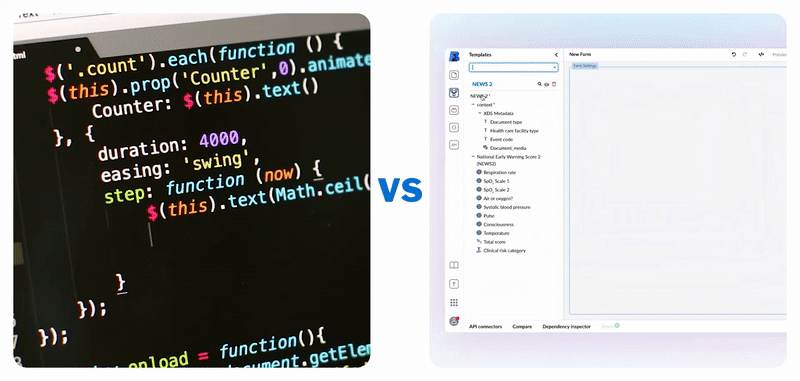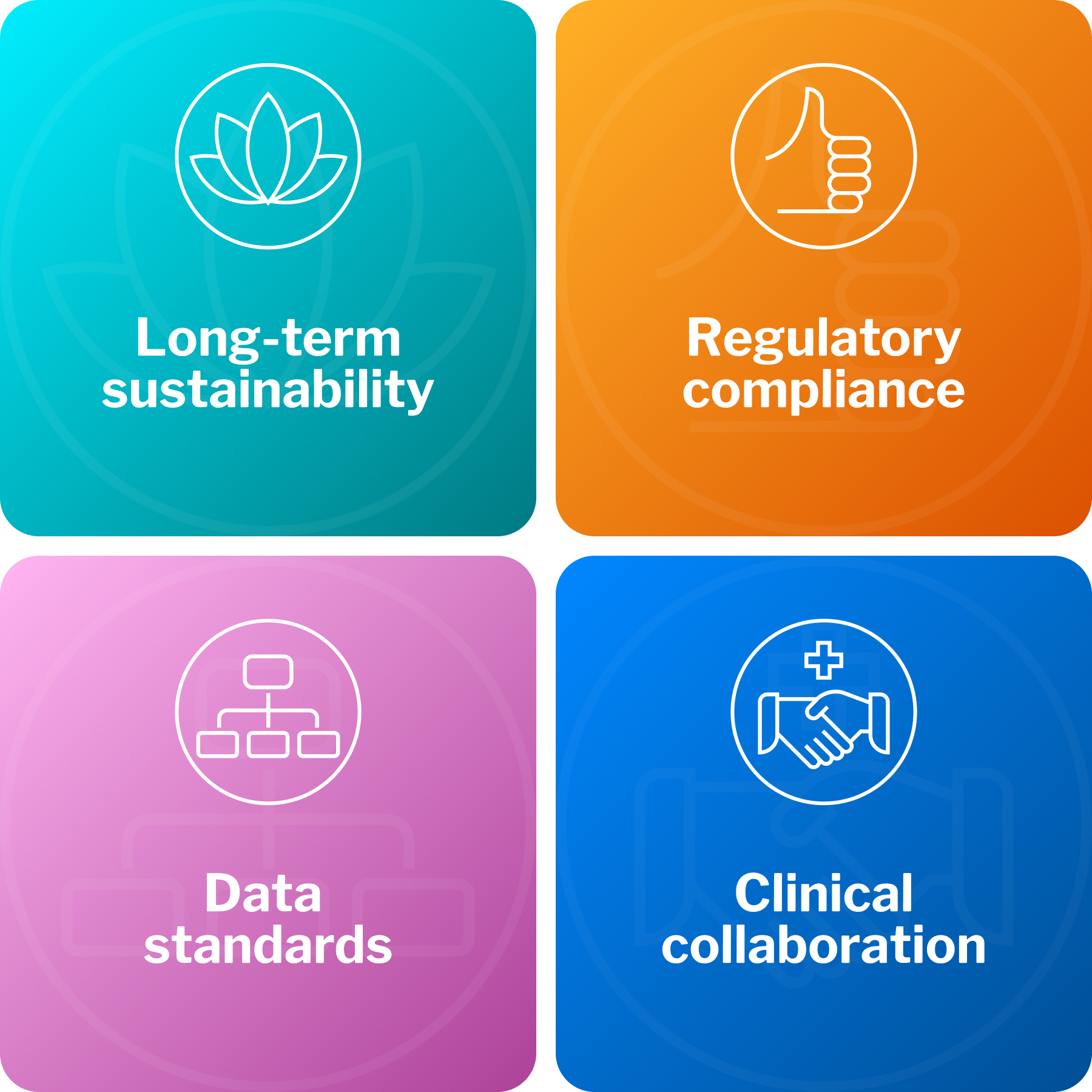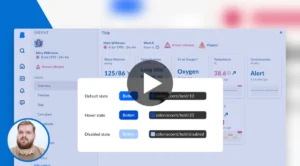Healthcare is under constant pressure to innovate, yet traditional software development simply can’t keep up. The rise of low-code in healthcare promises speed, agility, and lower costs, but speed alone is not enough. Without strong data standards, clinical collaboration, and long-term sustainability, low-code can become just another short-term fix. This blog explores why healthcare needs a domain-driven, data-first approach to low-code, and how Better Studio is redefining what is possible.
The low-code revolution
The way we build software is changing. For decades, building an application meant hiring developers, writing thousands of lines of code, and waiting months, if not years, for results. That model simply doesn’t work anymore in fast-moving industries like healthcare, where clinicians and IT teams need solutions yesterday.
Enter low-code development platforms: tools that allow professionals to design applications visually, using drag-and-drop interfaces, pre-built components, and reusable templates. These platforms promise faster time to market, reduced costs, and greater agility. For industries under pressure, such as healthcare, they provide a lifeline.

But not all low-code platforms are created equal. While most popular options were born as general-purpose tools, healthcare has unique challenges: sensitive patient data, strict regulation, complex workflows, and the critical need for interoperability. This is where data standards and healthcare-specific low-code come in.
Low-code in healthcare: A unique challenge
Healthcare is unlike retail, banking, or logistics. Apps in this space can’t just look pretty or automate simple processes. They need to safely interact with clinical data and support life-critical decisions.
That means:
✅ Data standards come first: Patient records must follow open standards like openEHR and FHIR, not proprietary schemas.
✅ Regulatory compliance is key: Applications must be compliant by design with GDPR and HIPAA, as well as NHS or other national and international frameworks.
✅ Long-term sustainability is a must: A patient’s medical record spans decades. Systems must ensure that data remains usable, reusable and transferable, even if software vendors change.
✅ Clinical collaboration becomes central: To bridge the gap between software development and patient care, healthcare apps need both IT teams and clinicians working together, rapidly prototyping, testing, and improving workflows.

The push for AI in healthcare makes this even more critical. Generic low-code platforms can integrate AI services, but without a healthcare-specific data foundation, those AI models risk being inaccurate or unsafe. If clinical data isn’t structured and standardised, AI outputs can’t be trusted in life-critical decisions. A healthcare-specific low-code approach ensures AI is trained and applied on clean, interoperable, and clinically valid data.
The popular low-code platforms
Before diving into healthcare-specific solutions, it is worth acknowledging the impressive work of the leading low-code platforms that have been driving this revolution for over a decade. They have paved the way for faster, more agile software delivery.
Mendix
Owned by Siemens, Mendix is a well-established low-code platform known for its enterprise-scale deployments. It offers strong integrations, AI-assisted development, and a broad developer community. Many large enterprises use Mendix to speed up digitalisation projects across industries from manufacturing to finance, but they lack healthcare specific features and healthcare specific data layer.
OutSystems
OutSystems focuses heavily on speed and scalability. It provides full-stack capabilities, from mobile apps to enterprise systems, and has a reputation for supporting complex enterprise-grade applications. Its marketplace of components is broad, but healthcare use cases typically require deep customization and heavy integrations with healthcare specific data standards.
Microsoft Power Apps
As part of the Microsoft Power Platform, Power Apps benefits from seamless integration with Microsoft 365, Dynamics, and Azure. It is great for quick internal apps and workflow automation, especially for organisations already invested in the Microsoft ecosystem. But again, healthcare-grade applications demand more than workflow automation, they demand structured, interoperable data handling.
Salesforce Lightning Platform
Built on the Salesforce CRM backbone, Lightning is strong in customer engagement and service applications. Its AppExchange marketplace is massive. However, its data model and design are inherently tied to CRM logic, making healthcare adaptation possible, but not natural.
Appian
Appian combines low-code with process automation and case management. It is widely used in financial services, government, and telecoms. Healthcare organisations can leverage it, but the clinical data layer must still be bolted on.
Where these platforms shine and where they may fall short for healthcare
Each of these platforms deserves recognition: they have democratised development and made businesses more agile. They have thriving ecosystems, developer communities, and years of proven deployments.
But in healthcare, the gaps are clear:
❌ Not data-first: None are built on open, vendor-neutral healthcare data standards (like openEHR).
❌ Not healthcare-specific: While they offer generic design systems, they don’t provide pre-built clinical components, patient dashboards, or validated medical forms.
❌ Not focused on sustainability: Healthcare data lives for decades. Proprietary data storage risks long-term lock-in.
❌ Not collaborative enough: Healthcare requires clinicians, IT, and data experts to work side by side. Most general-purpose platforms were not designed with clinicians in mind.
While these platforms can accelerate form building or workflow automation, they don’t natively understand clinical data or healthcare standards and lack clinical context in general.
It is the same story with AI. While platforms like Mendix, OutSystems, or Power Apps can add AI services for chatbots, predictions, or automation, these aren’t healthcare specific. Without access to longitudinal, standards-based clinical data, AI in healthcare becomes surface-level. True clinical AI requires deep integration with healthcare data models, something only a healthcare-first low-code platform can provide.
Low-code for healthcare, by healthcare
This is where Better Studio changes the story.
Unlike general-purpose low-code platforms, Better Studio is built for healthcare, from the ground up. As part of the Better Platform, a vendor-neutral digital health platform, based on openEHR and FHIR standards, Better Studio is a purpose specific, low-code solution for the healthcare industry.
Here is what makes Better Studio different:
- Data is at the core.
Better Studio natively integrates with openEHR clinical data repositories and FHIR operational data. This means every app built is interoperable, standards-based, and future-proof. No lock-in, no proprietary silos.
- Healthcare design system matters.
Out of the box, Better Studio comes with a design system tailored to healthcare: clinical forms, widgets for vital signs, medication components, patient lists, dashboards. No need to reinvent the wheel.
- Collaboration with clinicians made natural.
With its drag-and-drop App Builder and Query Builder, clinicians can directly shape applications without waiting months for IT teams. Development cycles shrink from months to hours.
- Healthcare marketplace as the nucleus for sharing.
Better Studio enables sharing and reuse of apps, widgets, and clinical models across organizations. Imagine an NHS Trust building a chemotherapy form and another reusing it instantly. That is real ecosystem value.
- Proven at scale.
Better already supports over 30 million patients across 27 countries, with national-level deployments in Greece, Slovenia, Malta, many UK and EU regions. This is not theory. It is production ready today.
- AI you can trust.
Because Better Studio is built on openEHR and FHIR, any AI applied through its platform has access to structured, high-quality, and clinically validated data. That means decision support, predictive modelling, or workflow automation are not just technically possible. They are safe, explainable, and scalable in real-world healthcare settings.
Real-world impact: healthcare at speed
Take EHA Clinics in Nigeria, which used Better Studio to build their EMR system. With just three team members, they developed 80 clinical use cases in 12 months, leveraging openEHR archetypes and reusing 90% of content from the Clinical Knowledge Manager.
Or the Christie NHS Foundation Trust, Europe’s largest single-site cancer centre. Using Better Studio, they built and deployed 24 electronic patient-reported outcome forms (ePROMs) in just 4 months, reducing clinic visits by 85% in some disease groups.
These are transformations that generic platforms simply cannot deliver without massive customisations, and at the same time paving the way for building the future healthcare ecosystem.
The future is domain-driven low-code
Low-code has already changed the way organisations build applications. Platforms like Mendix, OutSystems, Power Apps, Salesforce, and Appian have proven the model and created thriving ecosystems.
But healthcare is different. It needs a domain-driven low-code approach, one where data standards, clinical collaboration, and long-term sustainability are built in from the start.
That is why Better Studio isn’t just another low-code platform. It is a healthcare-specific low-code platform that empowers clinicians and IT teams to co-create, ensuring data remains open and future-proof, with the ability to scale to national healthcare systems.
The need for domain-driven low-code is even clearer with AI. AI without structured, interoperable data is risky; AI built on open standards and clinical collaboration is transformative. Better Studio ensures that when healthcare embraces AI, it does so safely, grounded in data standards, powered by clinicians, and built to last.
In other industries, low-code is about speed.
In healthcare, with Better Studio, it is about speed with safety, sustainability, and standards.
Discover how Better Studio is transforming healthcare with low-code built on open standards.
















